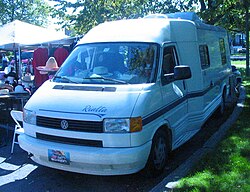Motorhome: Difference between revisions
Ken Gallager (talk | contribs) Undid revision 624122692 by 121.243.231.90 (talk) |
|||
| Line 61: | Line 61: | ||
* [http://www.motorhome-photos.net/ Photo forum and image library, with thousands of motorhome-photos] |
* [http://www.motorhome-photos.net/ Photo forum and image library, with thousands of motorhome-photos] |
||
* [http://festivalessentials.net/guide-buying-motorhome-camper/ Festivalessentials.net: Guide to buying a Motorhome / RV / Camper] |
* [http://festivalessentials.net/guide-buying-motorhome-camper/ Festivalessentials.net: Guide to buying a Motorhome / RV / Camper] |
||
* [http://video.fotki.com/AUTOBOSSRV/ Video and image library, with different motorhome] |
|||
[[Category:Recreational vehicles]] |
[[Category:Recreational vehicles]] |
||
Revision as of 04:37, 19 September 2014


A motorhome (or motor coach[1]) is a type of self-propelled recreational vehicle or RV which offers living accommodation combined with a vehicle engine. The term motorhome is most commonly used in the United Kingdom, United States and Canada.
Features


A motorhome comprises sleeping accommodation for between two and eight people. Each sleeping place is called a berth. Each berth is either fixed or converts from another part of the motorhome's interior, usually a fold out sofa. A kitchenette area will contain cooking equipment. The type of equipment included differs depending on the motorhome make and model, but generally a kitchenette has an oven, grill, stovetop, and sink. More luxury models may also provide a microwave. A separate washroom will be housed in the motorhome. Each washroom will have a flushing cassette toilet, shower and basin. The cassette toilet sometimes swivels to provide extra room and can be accessed from outside the motorhome for easy emptying.[2] More recent motorhomes will have a separate shower cubicle.
A motorhome will also have a cab area with a driver and passenger seat. These seats often swivel to become part of the living space. A dinette area provides a table and seating space typically used for eating meals. A lounge may also be included, consisting of either a U-shaped sofa located in the rear of the motorhome or a side lounge.
Ambiguity with RV and campervan
The term motorhome is often used interchangeably with (American) RV and campervans, though the terms are not entirely synonymous. Their term Recreational Vehicle (RV) is actually a blanket term that refers to all forms of mobile, temporary dwelling vehicles of this type (and as such includes motorhomes, as well as travel trailers, fifth wheels, and truck campers).
Campervans are typically smaller than motorhomes and are constructed differently. Whilst campervans are focused with mobility and low cost, motorhomes have more emphasis on comfort.[3] For example, campervans generally lack built-in toilets and showers, or a divide between the living compartment and the cab.[4] Volkswagen Westfalia Campers are typical campervans.
History
The origins of the motorhome date back to 1910 when the Pierce-Arrow motor company introduced the Touring Landau model at the Madison Square Garden auto show.[5] The Jennings company mounted a motorhome body onto a car chassis in 1938. Production was brought to a standstill in 1939, perhaps due to World War II. The war set back the progress of motorhome manufacturing, but it picked up again in the 1950s. The big names in the early days were Dormobile, Paralanian and Westfalia.[6]
Categories
Motorhomes can be roughly categorized into three categories:
- Class A (also known as Integrated)
- A Class A motorhome often has a reputation for being the most luxurious and expensive vehicles. It has a solid body with the driving area integrated into the standard living accommodation. This style of motorhome will have a large and expansive front window which offers a good view of the road and surrounding landscape. Berths convert from lounge or dinette areas.
- Class B (also known as Semi-integrated)
- A Class B motorhome is also referred to as a low profile or semi-integrated motorhome. It is built in the same way as a Class C motorhome, except no berths are provided over the cab area. As a result, the overall height of this motorhome is lower than a Class C. There is usually a fixed double bed in rear of the vehicle.
- Class C (also known as Alcove)
- A Class C motorhome may also be known as coach built. It has a trailer- or caravan-style body which is mounted onto a van or truck chassis. There is usually a double berth over the driving cab. Ford and Fiat manufacture the majority of these motorhome chasses in Europe.
Layouts

There are many different motorhome layouts available with each manufacturer offering a range of options.
Other terms
In the United Kingdom and United States, the word motorhome is commonly used. On occasion, other synonyms are used, such as motor home and motor caravan.
In Germany, a motorhome is referred to as a "Wohnmobil". In Sweden, the term "Husbil" means motorhome. In France, a motorhome is called a "camping-car". In Italy, the term "Camper" is used to mean motorhome in general, and the term "Motorhome" refers to Class A motorhomes in particular.[7] Spain and Portugal use "Auto Caravana" or "Auto-Caravana".
In Australia and New Zealand, the term campervan is frequently used for smaller motorhomes, and the term housebus is frequently used for larger motorhomes.
In some countries the proprietary name Winnebago has been largely genericised to refer to any motorhome.
See also
References
- ^ Family Motor Coach Association
- ^ "Motorhome Glossary". Motorhome Group.
- ^ "Campervans and motorhomes". Campervan Adventures.
- ^ "What are the Differences Between a Campervan and a Motorhome?". Discovery Homes New Zealand.
- ^ "History of the RV motorhome". rvmenu.com. Retrieved 2014-04-17.
- ^ "The History of Campers and Motorhomes". Classic-campers.co.uk. Retrieved 2010-12-09.
- ^ http://magazine.camperonline.it/2009/10/19/cosa-mi-compro/
Further reading
- Batten-Hill, David; Fiona Batten-Hill (2009). Motorhomes: The Complete Guide. London: Robert Hale Ltd Professional. ISBN 978-0-7090-8405-1. OCLC 237192658.
